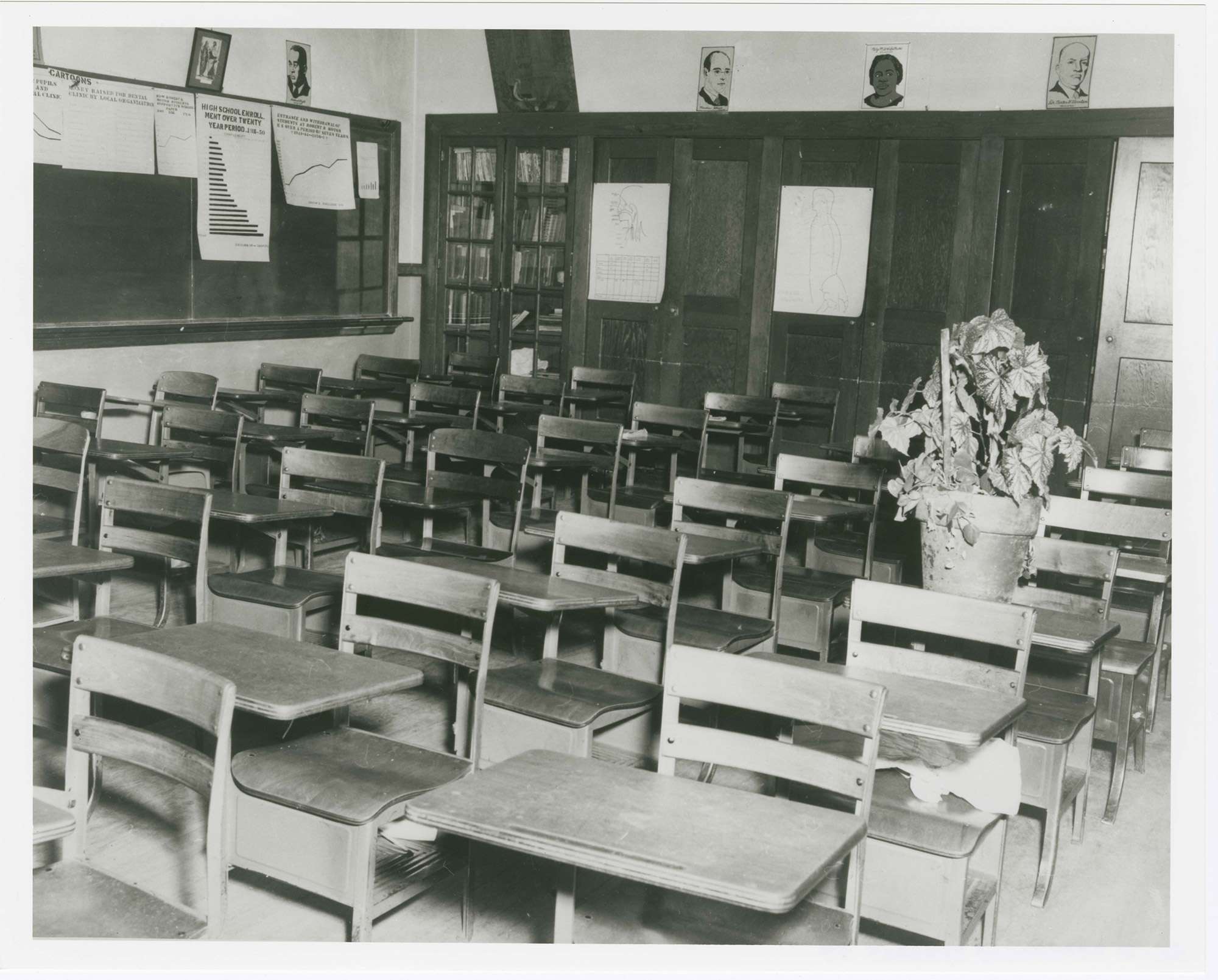R. R. Moton High School Classroom
6/9/1951
Add to Favorites:
Add all page(s) of this document to activity:

This photograph shows a classroom in Moton High School, a school for black students. It was used as Defendant's Exhibit No. 79, one of several photographs entered by the defendants to try to prove they were providing equal facilities in both black and white schools in the landmark Civil Rights case Dorothy E. Davis, et al. v. County School Board of Prince Edward County, et al.
In April 1951, students at Moton High School in Prince Edward County, VA, led by 16 year-old Barbara Johns, went on strike to persuade their local school board to build them a better school. Schools in Virginia were segregated at the time, and Moton was typical of the all-black schools in the county. It was built in 1939 to hold half as many students as it did by the early 1950s. Its teachers were paid substantially less than teachers at the nearby white schools. It had no gymnasium, cafeteria, or auditorium with fixed seats like Farmville or Worsham high schools, which were for white students.
The students asked for help from the National Association for the Advancement of Colored People (NAACP), who filed suit on behalf of the students against the school district. The first plaintiff listed was Dorothy E. Davis, a 14-year old ninth grader. The plaintiffs asked that the state law requiring segregated schools in Virginia be struck down.
In the spring of 1952, the U.S. District Court decided in favor of the school board and upheld segregation. On appeal, the case made it to the Supreme Court and was decided along with three other school segregation cases from South Carolina, Delaware, and Kansas, in Brown v. Board of Education of Topeka. The Brown decision marked the end of the "separate but equal" precedent set nearly 60 years earlier in Plessy v. Ferguson, stating that "separate educational facilities are inherently unequal," and that school segregation violated the Fourteenth Amendment.
The Commonwealth of Virginia, and Prince Edward County in particular, resisted the Supreme Court's decision. The county closed its public schools from 1959 to 1964 to avoid desegregation.
In April 1951, students at Moton High School in Prince Edward County, VA, led by 16 year-old Barbara Johns, went on strike to persuade their local school board to build them a better school. Schools in Virginia were segregated at the time, and Moton was typical of the all-black schools in the county. It was built in 1939 to hold half as many students as it did by the early 1950s. Its teachers were paid substantially less than teachers at the nearby white schools. It had no gymnasium, cafeteria, or auditorium with fixed seats like Farmville or Worsham high schools, which were for white students.
The students asked for help from the National Association for the Advancement of Colored People (NAACP), who filed suit on behalf of the students against the school district. The first plaintiff listed was Dorothy E. Davis, a 14-year old ninth grader. The plaintiffs asked that the state law requiring segregated schools in Virginia be struck down.
In the spring of 1952, the U.S. District Court decided in favor of the school board and upheld segregation. On appeal, the case made it to the Supreme Court and was decided along with three other school segregation cases from South Carolina, Delaware, and Kansas, in Brown v. Board of Education of Topeka. The Brown decision marked the end of the "separate but equal" precedent set nearly 60 years earlier in Plessy v. Ferguson, stating that "separate educational facilities are inherently unequal," and that school segregation violated the Fourteenth Amendment.
The Commonwealth of Virginia, and Prince Edward County in particular, resisted the Supreme Court's decision. The county closed its public schools from 1959 to 1964 to avoid desegregation.
This primary source comes from the Records of District Courts of the United States.
National Archives Identifier: 76043534
Full Citation: R. R. Moton High School Classroom; 6/9/1951; Civil Action No. 1333; Dorothy E. Davis, et al. v. County School Board of Prince Edward County et al.; Civil Case Files, 1938 - 12/31/1995; Records of District Courts of the United States, Record Group 21; National Archives at Philadelphia, Philadelphia, PA. [Online Version, https://www.docsteach.org/documents/document/moton-high-classroom, April 19, 2024]Rights: Public Domain, Free of Known Copyright Restrictions. Learn more on our privacy and legal page.



